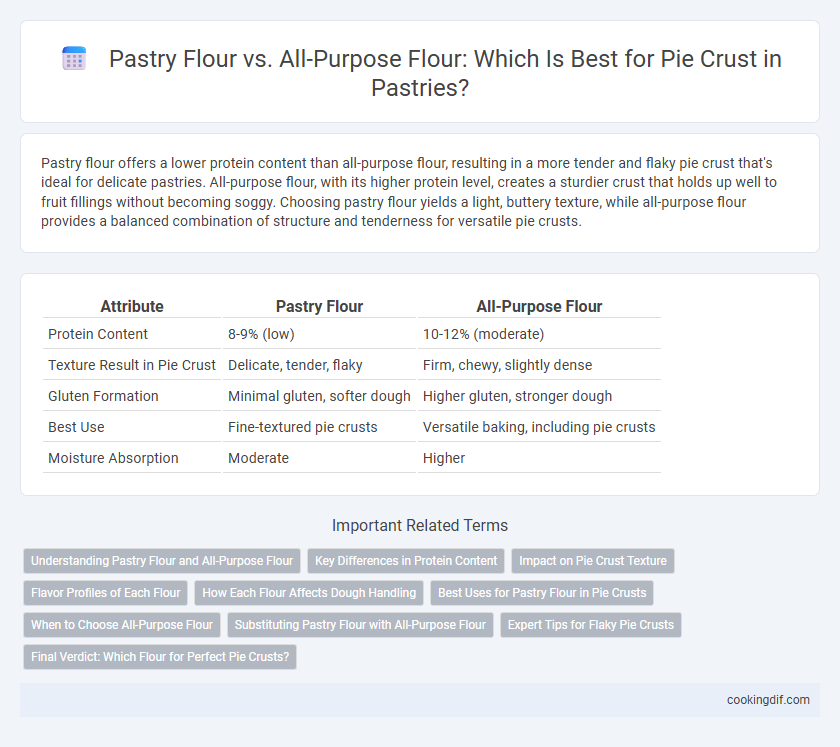Pastry flour offers a lower protein content than all-purpose flour, resulting in a more tender and flaky pie crust that's ideal for delicate pastries. All-purpose flour, with its higher protein level, creates a sturdier crust that holds up well to fruit fillings without becoming soggy. Choosing pastry flour yields a light, buttery texture, while all-purpose flour provides a balanced combination of structure and tenderness for versatile pie crusts.
Table of Comparison
| Attribute | Pastry Flour | All-Purpose Flour |
|---|---|---|
| Protein Content | 8-9% (low) | 10-12% (moderate) |
| Texture Result in Pie Crust | Delicate, tender, flaky | Firm, chewy, slightly dense |
| Gluten Formation | Minimal gluten, softer dough | Higher gluten, stronger dough |
| Best Use | Fine-textured pie crusts | Versatile baking, including pie crusts |
| Moisture Absorption | Moderate | Higher |
Understanding Pastry Flour and All-Purpose Flour
Pastry flour contains approximately 8-9% protein, lower than all-purpose flour's 10-12%, resulting in a tender, flaky pie crust due to reduced gluten development. All-purpose flour, with its balanced protein content, provides more structure and chewiness, making it versatile but potentially less delicate for pie crusts. Choosing pastry flour enhances lightness and crispness, while all-purpose flour delivers sturdier dough, influencing the crust's texture and flakiness.
Key Differences in Protein Content
Pastry flour contains approximately 8-9% protein, which is lower than the 10-12% found in all-purpose flour, resulting in a more tender and flaky pie crust. The reduced protein content in pastry flour limits gluten development, allowing the crust to maintain a delicate texture without becoming tough. In contrast, all-purpose flour's higher protein strengthens the dough, producing a firmer crust but with less flakiness.
Impact on Pie Crust Texture
Pastry flour produces a tender, flaky pie crust due to its lower protein content (around 8-9%), which limits gluten development and creates a softer texture. All-purpose flour, with a higher protein content (10-12%), results in a firmer, chewier crust that may lack the delicate flakiness desired in pies. Using pastry flour enhances the pie crust's lightness and crumbly layers, making it ideal for achieving a classic, buttery texture.
Flavor Profiles of Each Flour
Pastry flour, with its lower protein content (8-9%), produces a tender, delicate pie crust that enhances the buttery, flaky texture while allowing subtle buttery and sweet flavors to shine. All-purpose flour, containing more protein (10-12%), creates a sturdier crust with a slightly chewier texture and a nuttier flavor profile due to increased gluten development. Choosing pastry flour results in a lighter, more melt-in-the-mouth crust, while all-purpose flour delivers a heartier bite with deeper, toasty notes.
How Each Flour Affects Dough Handling
Pastry flour contains a lower protein content (8-9%) compared to all-purpose flour (10-12%), resulting in a more tender and delicate pie crust that is easier to roll and shape without tearing. The reduced gluten formation in pastry flour yields a dough that is less elastic and more manageable, preventing excessive shrinkage during baking. In contrast, all-purpose flour provides a stronger gluten network, producing a firmer dough that can be tougher to handle but offers a slightly chewier texture in the finished crust.
Best Uses for Pastry Flour in Pie Crusts
Pastry flour, with its lower protein content (8-9%) compared to all-purpose flour (10-12%), creates a tender, flaky pie crust ideal for delicate pastries and fruit pies. Its fine texture and moderate gluten strength ensure a crumbly yet sturdy crust that resists toughness, making it perfect for buttery crusts requiring a light, melt-in-your-mouth consistency. Bakers seeking a balance between durability and softness often choose pastry flour to achieve flaky layers without the chewiness common in all-purpose flour crusts.
When to Choose All-Purpose Flour
Choose all-purpose flour for pie crusts when a sturdier, less tender texture is desired, as its higher protein content (typically 10-12%) develops more gluten compared to pastry flour's 8-9%. This makes all-purpose flour ideal for fruit pies and savory tarts that require robust structure to hold fillings. Its versatility and availability make it a convenient option for bakers seeking a balance between flakiness and durability in pie crusts.
Substituting Pastry Flour with All-Purpose Flour
Substituting pastry flour with all-purpose flour in pie crust recipes often results in a slightly tougher crust due to higher protein content, which increases gluten formation. Pastry flour, with its lower protein level (around 8-9%), ensures a tender, flaky texture essential for delicate pie crusts. Adjusting the dough by reducing mixing time and adding a bit more fat or a tablespoon of cornstarch can help mimic pastry flour's characteristics when using all-purpose flour.
Expert Tips for Flaky Pie Crusts
Pastry flour contains a lower protein content (8-9%) compared to all-purpose flour (10-12%), resulting in less gluten formation and a more tender, flaky pie crust. Experts recommend using pastry flour for pie crusts to achieve optimal flakiness, as it produces a delicate texture without sacrificing structure. For best results, keep ingredients cold and handle the dough minimally to preserve the flakiness enhanced by the finer, softer pastry flour.
Final Verdict: Which Flour for Perfect Pie Crusts?
Pastry flour, with its lower protein content of 8-9%, produces a tender and flaky pie crust by minimizing gluten development, which is ideal for delicate textures. All-purpose flour, averaging 10-12% protein, creates a slightly chewier crust with more structure, suitable for sturdier pies. For perfect pie crusts, pastry flour is recommended to achieve optimal flakiness and tenderness, especially in recipes prioritizing a light, melt-in-the-mouth texture.
Pastry flour vs All-purpose flour for pie crust Infographic

 cookingdif.com
cookingdif.com